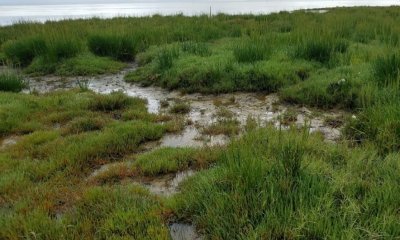
Tidal Marsh and Estuary
Scenario model
Current ecosystem state
Select a state
Management practices/drivers
Select a transition or restoration pathway
- Transition T1A More details
- Transition T2A More details
- Transition T3A More details
- Restoration pathway T1B More details
- Transition T1C More details
- Restoration pathway T2B More details
- Transition T2C More details
- Restoration pathway T3B More details
-
No transition or restoration pathway between the selected states has been described
Target ecosystem state
Select a state
Submodel
Submodel
Mechanism
This pathway represents human-influenced hydrologic changes such as construction of dikes, levees, drainage structures, and dams. This increases freshwater inputs, decreases saline inputs, and reduces connectivity between the upland and wetland areas.
Mechanism
This pathway represents a major disturbance from a massive tidal surge, an excessively damaging windstorm, or extended drought that removes most, if not all, of the existing vegetation. It also represents a transition from a native plant community to a non-native, invaded plant community. Non-native seed disbursement is introduced (intentionally or unintentionally), which alters the reference community.
Mechanism
This pathway represents a transition from human-influenced hydrologic changes and cultivation of commercial crops or pasture.
Mechanism
This pathway represents a hydrologic change to restore the tidally influenced native plant habitat.
Mechanism
This pathway represents human-influenced hydrologic changes such as construction of dikes, levees, drainage structures, and dams to establish cultivated crops or pasture.
Mechanism
This pathway represents restoration of the native plant community. Native seed sources and extensive management and mitigation of non-native species are needed to restore the community.
Mechanism
This pathway represents human-influenced hydrologic changes such as the construction of dikes, levees, drainage structures, and dams to establish cultivated crops or pasture.
Model keys
Briefcase
Add ecological sites and Major Land Resource Areas to your briefcase by clicking on the briefcase (![]() ) icon wherever it occurs. Drag and drop items to reorder. Cookies are used to store briefcase items between browsing sessions. Because of this, the number of items that can be added to your briefcase is limited, and briefcase items added on one device and browser cannot be accessed from another device or browser. Users who do not wish to place cookies on their devices should not use the briefcase tool. Briefcase cookies serve no other purpose than described here and are deleted whenever browsing history is cleared.
) icon wherever it occurs. Drag and drop items to reorder. Cookies are used to store briefcase items between browsing sessions. Because of this, the number of items that can be added to your briefcase is limited, and briefcase items added on one device and browser cannot be accessed from another device or browser. Users who do not wish to place cookies on their devices should not use the briefcase tool. Briefcase cookies serve no other purpose than described here and are deleted whenever browsing history is cleared.
Ecological sites
Major Land Resource Areas
The Ecosystem Dynamics Interpretive Tool is an information system framework developed by the USDA-ARS Jornada Experimental Range, USDA Natural Resources Conservation Service, and New Mexico State University.


